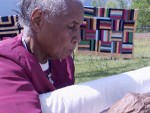Title
Artistic experiences enrich us all—the professional and the amateur. A recently released documentary film, Do Not Go Gently (directed and produced by Melissa Godoy, with executive producer Eileen Littig) explores the experiences of two groups of people of advanced age: those who have spent their lives developing their creativity and are lifelong learners and practitioners within their given artistic fields, and those who approach art anew in their retirement years. “All we were really trying to say was how important imagination is to being human,” said Godoy in a press conference last May when the film was shown on PBS television. Imagination, it seems, is more durable even than memory—a revelation that is inspiring new treatments and exploratory experiences for Alzheimer’s patients. Godoy explained to me that she became interested in the power of imagination while interviewing Alzheimer’s patients for a different project. She had been impressed by the creative phrasing of their responses, finding that their humanity was intact. Do Not Go Gently became a way of exploring the brain, the spirit, and the process of aging.
Frederic Franklin demonstrates one of his first roles as the Spirit of Creation in Massine's 1938 Seventh Symphony for the Ballet Russe de Monte Carlo.
The 109-year-old composer Leo Ornstein at the nursing home in Green Bay, Wis., where he spent his final years.
Body
The three lifelong creative artists the film follows are the quiltmaker Arlonzia Pettway, the dancer Frederic Franklin, and the pianist and composer Leo Ornstein. Narrated by esteemed journalist Walter Cronkite, the film has several connections to Juilliard: Leo Ornstein graduated from the Institute of Musical Art (Juilliard’s precursor), and Frederic Franklin received an honorary doctorate from Juilliard in May 2007. Jeni Dahmus, Juilliard’s archivist, provided research assistance to the filmmakers.
Arlonzia Pettway, from Gee’s Bend, Ala., began quilting when she was 9, and was still quilting until she had a stroke in the summer of 2006 at age 83. She is recovering slowly. As a young woman, Pettway quilted to provide warm covers for her children. Later she quilted because she found great enjoyment in it. Not only was her mind kept active through creating and designing, but she also experienced the joy of community with fellow quilters. Pettway’s quilts, along with others from Gee’s Bend, have been touring the United States to critical acclaim since 2002. The quilt designs reflect ideas we are familiar with from modern art, though Pettway and her friends and neighbors were exploring these concepts without influence from outside Gee’s Bend. The quilts passed down through my own family are classic designs, repeated over and over; not so the quilts of Gee’s Bend, which express diverse themes and motifs with uninhibited imagination, never stifled by ideas of what a quilt should look like or what art should be.
Franklin has maintained a continuous presence in the dance field for the past 76 years. Born in Liverpool, England, in 1914, Franklin began his career as a back-up dancer for Josephine Baker in Paris in 1931. He joined the Markova-Dolin Ballet Company in 1935, followed by the Ballet Russe de Monte Carlo in 1937, where he originated roles in such ballets as Agnes de Mille’s Rodeo and George Balanchine’s La Sonnambula, touring the far reaches of the U.S. and introducing professional ballet to this country. At a dance performance today, you may see him onstage in a character role—or he might be sitting behind you in the audience, as he was at a recent American Ballet Theater performance I attended. He has also been restaging works in which he has danced that have fallen out of repertory. His animated presence surges with joie de vivre: “I’m around young people every day of my life, all young, and I suppose I take from them. And they won’t allow me to be old. They won’t!” he says in the film. The young dancers benefit as much from Franklin’s years of experience as he benefits from the community his continued involvement in dance provides.
Born in 1892 in Russia, Ornstein began his musical study with Alexander Glazunov at the Imperial Music School in St. Petersburg. In 1906, his family immigrated to the U.S. to escape the violence toward Jews in Russia. Ornstein enrolled at the Institute for Musical Art, earning a diploma in piano in 1910. He built an impressive career as one of the most sought-after concert pianists from around 1910-25, introducing American audiences to works by Ravel, Stravinsky, Debussy, Bartok, and others. His own compositions were hailed by music critic James Huneker in 1917, who called Ornstein “most emphatically, the only true-blue, genuine, Futurist composer alive.” By 1933 he had ceased performing publicly and, with his wife, established a school in Philadelphia, where they taught until the mid-’50s. Ornstein was so much out of the public eye that when researcher Vivian Perlis went looking for him in 1977, she found Ornstein and his wife living in a trailer park in Brownsville, Tex. Ornstein composed his last major work, Piano Sonata No. 8, in 1990, at the age of 98, but according to an employee at the nursing home where he spent his last years, he was always humming—his mind still engaged in creative outpouring. Unlike Pettway and Franklin, Ornstein eschewed artistic community for much of his life, composing in isolation. He lived to be 109, dying in February 2002, just two weeks after his final interview for this film.
Also discussed in the film are elder-care sites at which creative arts are practiced, exploring how they benefit the bodies and minds of participants. For practicing artists, this is not news; it is something known on a deep psychological and visceral level. But the film puts this information out in front, and by doing so may inspire us to rethink our concepts about retirement.
Do Not Go Gently touched me deeply on a personal level, inspiring me to imagine possibilities for my generation’s retirement years—and also reminding me how rich my life has been in relationships with people of advanced age. At Juilliard alone, there were my teachers Martha Hill, Ethel Winter, Alfredo Corvino, and Anna Sokolow, from whom I learned what it means to be a professional while retaining one’s deeper sense of humanity. Our society has not, as a rule, been kind to those of advancing years. As the population over 85 continues to grow, how will that change?







